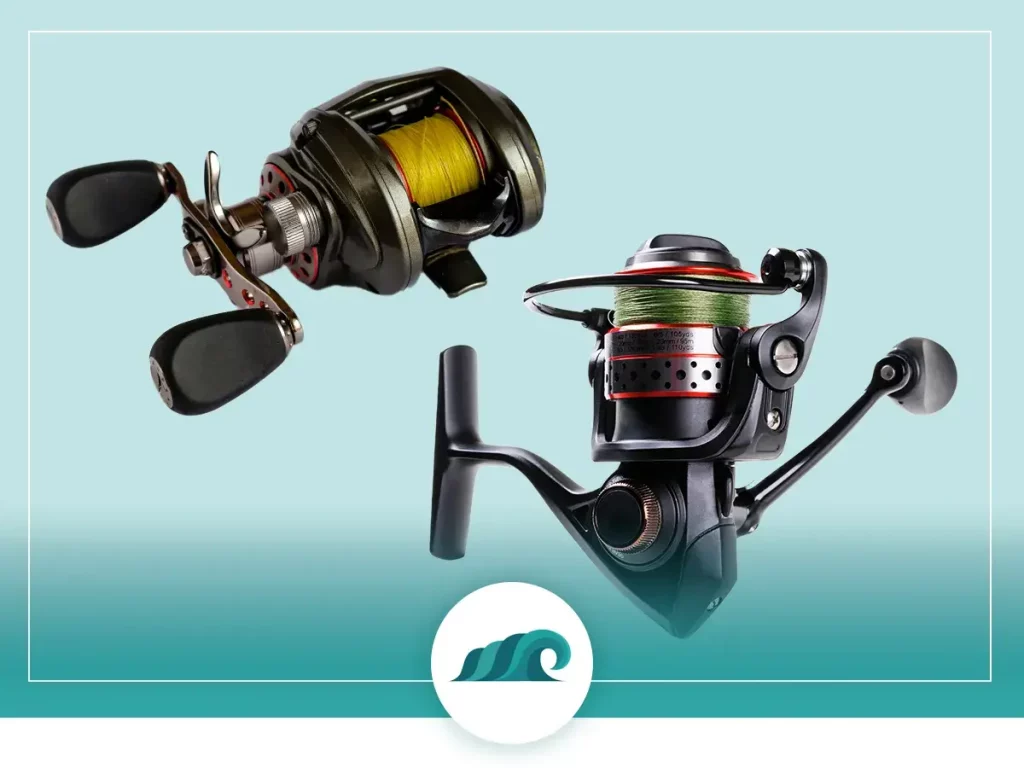If you’ve been shopping around for fishing reels, there’s a good chance you’ve come across the perplexing world of fishing reel gear ratios. Gear ratios are one of the key components of any fishing reel, so gaining a basic understanding of them will help you select the right reel for the job.
In simple terms, a reel’s gear ratio refers to the number of times the spool turns for each complete rotation of the reel handle. So, for a reel with a gear ratio of 6:1, a single turn of the handle will rotate the spool 6 times.
The higher the gear ratio gets, the faster the retrieve becomes, but the less power and torque it has. Conversely, the lower the ratio is the more powerful the retrieve will be, but at the expense of speed.
I’ll break down what you need to know about fishing reel gear ratios, and hopefully help you narrow down your reel selection process.
What Gear Ratio Do You Need?

Now that you understand the basics of gear ratios, how do you determine what ratio is necessary for your fishing style?
Well, like other variables such as spool size, drag, and reel size, there is no single best gear ratio for every situation. The right reel gearing is highly situation-dependent, which is why you’ll often find anglers using multiple rigs with different reel gear ratios.
Low Gear Ratio
Low gear ratios (typically in the 4:1 to 5:1 range), are ideal for fishing with large baits and lures, like deep diving crankbaits, large swimbaits, or deep spinnerbaits. The powerful torque provided by these lures gives you muscle to fight powerful fish, while the inherent slow retrieve provides ideal control and a realistic movement to your lure.
Medium Gear Ratio
Reels in the 6:1 gear range are some of the most common ones out there and serve as great do-it-all reels for fishing with a variety of techniques and presentations. There are slow enough to fish lures slowly and quick enough to use a fast retrieve when necessary.
Most spinnerbaits, jerkbaits, topwater lures, and medium depth crankbaits will work well with a medium retrieve. A medium retrieve presents these lures with the ideal behavior pattern, allowing them to be maximally effective.
If you only were to own a single reel, one with a medium gear ratio would be the way to go.
Fast Gear Ratio
Fast gear ratios (7:1 and up) are used for lures that you work primarily with your rod tip, or for fishing in heavy cover where you need to be able to quickly pull a fish away from cover to avoid entanglement. These gear ratios are also helpful when you’re targeting smaller, fast-moving fish that require the extra zip during the retrieve.
Baits and lures with swift, jerky movements benefit from this type of lure. Think of jigs, jerkbaits, worms, topwaters, and lipless crankbaits.
2-Speed Reels
2-speed reels have been around for decades, but it’s only within the last ten years or so that they’ve become popular among saltwater anglers. These reels are typically found on large offshore tuna and billfish rigs, and allow you to switch between a high and a low gear ratio as you see fit.
The advantage of a two-speed reel for this type of fishing is that it enables you to use the high gear for casting on the surface and high-speed jigging, and then switch to low-gear when you need the extra torque to fight a monster offshore fish into your boat.
Baitcasting vs. Spinning Reel Gear Ratios

Reel gear ratios also differ depending on the reel type. Baitcasting reels generally have a larger range of gear ratios available than spinning reels.
Spinning reels typically have ratios between 5:1 and 6.5:1, although 7:1 gear ratios are also increasingly available. Baitcaster reels are commonly available in a wide range of gear ratios, with anything from 4:1 all the way up to ultra-high 10:1 reels being commonly used by anglers.
The design of these reels also means the ratio indicates slightly different things.
For spinning reels, the ratio is a measurement of how many times the bail rotates around the spool for each turn of the reel handle. So, the spool diameter will have an impact on how much line is actually retrieved per turn. As spinning reels tend to have wider spools than baitcasters, they will be affected less by changes in the ratio. Their rotors also have a wider arc – which results in significantly more line retrieved per turn.
This leads us to another important measurement for determining a reel’s retrieval speed – the IPT.
IPT (Inches per Turn)

Inches per turn are a measure of exactly how many inches of line are retrieved with every single turn of the reel handle. As each reel has differing spool diameters, only using the gear ratio number can give you a misleading picture of the retrieval speed.
IPT is calculated by multiplying the spool diameter by the reel’s gear ratio.
IPT = Spool Diameter X Gear Ratio
So, for example, if a reel has a gear ratio of 6.4:1 and a spool diameter of 4”, then the IPT would be 25.6”. Alternatively, the same reel with a 5” spool will have an IPT of 32”.
Generally, a high IPT number will be in the high 20”s and above. A medium IPT would be 25” to 27”, and a low IPT would be 21” to 24”. There are reels that will fall outside this range, but the majority of reels are offered in these ranges.
Keep in mind that IPT is measured at full spool. So, if half your line is out, your effective IPT will be lower than when you’ve reeled all your line in.




